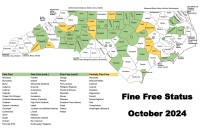Cherokee leaders contemplate second casino in Murphy
 The Eastern Band of Cherokee Indians could decide soon whether to move forward with a second casino near Murphy, but some tribal members are raising concerns.
The Eastern Band of Cherokee Indians could decide soon whether to move forward with a second casino near Murphy, but some tribal members are raising concerns.
With sequestration threat looming, Eastern Band preps for the worst
The Eastern Band of Cherokee Indians could see an estimated $2.2 million evaporate from its budget in March if Congress does not reach an agreement on the federal budget and mandatory, across-the-board cuts of 5.1 percent known as sequestration kick in.
The threat of sequestration was supposed to be an incentive for divisive lawmakers to come to an agreement on where to rein in spending and where to raise additional revenue.
Cherokee entertains idea of bear sanctuary
Tribal Council for the Eastern Band of Cherokee Indians has postponed any action that would ban bear zoos from the reservation for good.
A few tribal members called on Tribal Council last week to revoke the business licenses for any private establishments that display caged animals for profit on the reservation and force those establishments to release the animals.
Conviction in toddler’s death just ‘one step’ on the families’ road to justice
 A woman was sent to jail for nine years this week for her role in the death of toddler who likely succumbed to hypothermia on the floor of a single-wide trailer one bitterly cold night in Swain County two years ago.
A woman was sent to jail for nine years this week for her role in the death of toddler who likely succumbed to hypothermia on the floor of a single-wide trailer one bitterly cold night in Swain County two years ago.
Cherokee ups the ante for early landslide repairs to Smokies road
 The Eastern Band of Cherokee Indians and the National Park Service are offering up to a $500,000 incentive for early completion of landslide repairs to U.S. 441 through the Great Smoky Mountains National Park — indicating both entities’ concerns about the road closure’s effects on Cherokee’s economy.
The Eastern Band of Cherokee Indians and the National Park Service are offering up to a $500,000 incentive for early completion of landslide repairs to U.S. 441 through the Great Smoky Mountains National Park — indicating both entities’ concerns about the road closure’s effects on Cherokee’s economy.
Cherokee bear zoo fined and suspended over violations
 Federal regulators temporarily suspended operations at Cherokee bear zoo and fined its owners $5,000 for repeated animal welfare violations.
Federal regulators temporarily suspended operations at Cherokee bear zoo and fined its owners $5,000 for repeated animal welfare violations.
Cherokee leaders make their case for a indoor adventure park
 A $93 million family adventure park in Cherokee would likely turn a profit during its first year of operation, according to early projections from the Eastern Band of Cherokee Indians’ finance department.
A $93 million family adventure park in Cherokee would likely turn a profit during its first year of operation, according to early projections from the Eastern Band of Cherokee Indians’ finance department.
Can the digital age save the Cherokee language? The halls of Facebook, Google and texting
 Susan Gathers was kicked back in the student union one afternoon, her thumbs poised over her smart phone, simultaneously bantering with friends while texting — sometimes even texting the same person she was talking to.
Susan Gathers was kicked back in the student union one afternoon, her thumbs poised over her smart phone, simultaneously bantering with friends while texting — sometimes even texting the same person she was talking to.
This impressive skill to seamlessly dialogue in multiple mediums at once is nothing new for “Generation Next-ers” like Gathers. But unlike the typical truncated words and vowel-less abbreviations that permeate normal text-speak, her screen was filled with Cherokee syllables as she pushed send.
Theories swirl around perplexing mountain lights
 Ghosts, spirits, swamp gas, gnomes and car headlights — there’s no shortage of hyphotheses behind the mysterious phenomenon along the Blue Ridge Parkway. The real question is, though, have you seen the light?
Ghosts, spirits, swamp gas, gnomes and car headlights — there’s no shortage of hyphotheses behind the mysterious phenomenon along the Blue Ridge Parkway. The real question is, though, have you seen the light?
Tribe keeps tap flowing for Sequoyah a while longer
“If at first you don’t succeed, simply make your case again” is the lesson the executives at the tribally owned Sequoyah National Golf Course learned earlier this month.
The Eastern Band of Cherokee Indians has been propping up the golf course financially to the tune of about $1.1 million annually since it first opened in 2009. But tribal council signaled last year they wanted to scale back and eventually end the subsidies.





